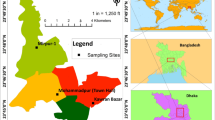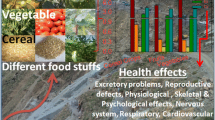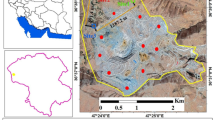Abstract
The purpose of this study was to assess heavy metal contamination in soil, plants, earthworms, and chicken in farmlands adjacent to an old mining site and to evaluate the potential exposure risks to humans through the consumption of chicken. For this purpose, soil, earthworms, plant, chickens, and eggs were sampled from 5 sites following a gradient of contamination. All samples were analyzed for heavy metals (Pb, Cd, Cu, and Zn). A food chain model was used in order to characterize heavy metal transfer between soil-plant-earthworm and chicken organs. Furthermore, target hazard quotient (THQ), estimated daily intake (EDI), and hazard index (HI) were employed to assess human health risks posed by heavy metal contamination. Despite the higher level of Pb, our data related to the calculation of EDI and THQ suggested that local consumers are more at risk of Cd contamination. The calculated HI showed values ranging from 2.58 to 4.74 for adults, and up to 12.34 for children, indicating a considerable risk to the health of local inhabitants, especially children. This study highlighted the crucial role of diets based on chickens grown in contaminated areas, on health risks especially for children.

Similar content being viewed by others
Data availability
All data generated or analyzed during this study are included in this published article.
References
Abdulkhaliq A, Swaileh KM, Hussein RM, Matani M (2012) Levels of metals (Cd, Pb, Cu and Fe) in cow’s milk, dairy products and hen’s eggs from the West Bank, Palestine. Int Food Res J 19(3):1089–1094
Adams ML, Zhao FJ, McGrath SP, Nicholson FA, Chambers BJ (2004) Predicting cadmium concentrations in wheat and barley grain using soil properties. J Environ Qual 33:532–541. https://doi.org/10.2134/jeq2004.5320
Banni M, Sforzini S, Arlt VM, Barranger A, Dallas LJ, Oliveri C, Aminot Y, Pacchioni B, Millino C, Lanfranchi G, Readman JW, Moore MN, Viarengo A, Jha AN (2017) Assessing the impact of benzo[a]pyrene on marine mussels: application of a novel targeted low density microarray complementing classical biomarker responses. PLoS One 12(6):e0178460. https://doi.org/10.1371/journal.pone
Béjaoui I, Kolsi-Benzina N, Sappin-Didier V, Munoz M (2016) Health risk assessment in calcareous agricultural soils contaminated by metallic mining activity under mediterranean climate. Clean - Soil, Air, Water 44(10):1385–1395. https://doi.org/10.1002/clen.201500512
Bernard A (2008) Cadmium & its adverse effects on human health. Indian J Med Res 128(4):557–564 http://hdl.handle.net/2078.1/35901
Boughattas I, Hattab S, Boussetta H, Sappin-Didier V, Viarengo A, Banni M, Sforzini S (2016) Biomarker responses of Eisenia andrei to a polymetallic gradient near a lead mining site in North Tunisia. Environ Pollut 530-541:530–541. https://doi.org/10.1016/j.envpol.2016.07.033
Boughattas I, Hattab S, Boussetta H, Banni M, Navarro E (2017) Impact of heavymetal contamination on oxidative stress of Eisenia andrei and bacterial community structure in Tunisian mine soil. Environ Sci Pollut Res 24. https://doi.org/10.1007/s11356-017-9449-8.
Boughattas I, Hattab S, Boussetta H, Alphonse V, Livet A, Giusti-Miller S, Banni M, Bousserrhine N (2018) Use of earthworms Eisenia andrei on the bioremediation of contaminated area in north of Tunisia and microbial soil enzymes as bioindicator of change on heavy metals speciation. J Soils Sediments. https://doi.org/10.1007/s11368-018-2038-8
Bouraoui Z, Banni M, Chouba L, Ghedira J, Clerandeau C, Jebali J, Narbonne JF, Boussetta (2010) Monitoring pollution in Tunisian coasts using a scale of classification based on biochemical markers in worms Nereis (Hediste) diversicolor.H.Environ Monit Assess 164(1-4):691–700. https://doi.org/10.1007/s10661-009-0921-x
Brus DJ, de Gruijter JJ, Walvoort DJJ, de Vries F, Bronswijk JJB, Romkens PFAM, De Vries W (2002) Map** the probability of exceeding critical thresholds for cadmium concentrations in soils in the Netherlands. J Environ Qual 31:1875–1884. https://doi.org/10.2134/jeq2002.1875
Chowdhury S, Mazumder Jafar MA, Al-Attas O, Husain T (2011) Heavy metals in drinking water: occurrences, implications, and future needs in develo** countries. Sci Total Environ 569-570:476–488. https://doi.org/10.1016/j.scitotenv.2016.06.166
De Vries W, Römkens PFAM, Schütze G (2007) Critical soil concentrations of cadmium, lead, and mercury in view of health effects on humans and animals. Rev Environ Contam Toxicol 191:91–130. https://doi.org/10.1007/978-0-387-69163-3_4
Duran A, Tuzen M, Soylak M (2009) Preconcentration of some trace elements via using multiwalled carbon nanotubes as solid phase extraction adsorbent. J Hazard Mater 169:466–447. https://doi.org/10.1016/j.jhazmat.2009.03.119
Efroymson AR, Sample EB, Suter WG (2001) Uptake of inorganic chemicals from soil by plant leaves: regressions of field data. Environ Toxicol 20:2561–2571. https://doi.org/10.1002/etc.5620201123
Elkribi-Boukhris S, Boughattas I, Zitouni N, Hellaoui S, Sappin-Didier V, Coriou C, Bussiere S, Banni M (2020) Ecotoxicity of trace elements to chicken GALLUS gallus domesticus exposed to a gradient of polymetallic-polluted sites. Environ.Pollut. 265:114831. https://doi.org/10.1016/j.envpol.2020.114831
FAO/WHO (1989) National Research Council Recommended Dietary Allowances (10th ed). National Academy Press, Washington, DC
FDA (Food and Drug Agency), 2011. Fish and fisheries products hazards and controls guidance, 3rd edn. Center for Food
Franz E, Römkens P, van Raamsdonk L, van der Fels-Klerx I (2008) Chain modeling approach to estimate the impact of soil cadmium pollution on human dietary exposure. J Food Prot 71:2504–2513. https://doi.org/10.4315/0362-028X-71.12.2504
Ghorbel M, Munoz M, Solmon F (2014) Health hazard prospecting by modeling wind transfer of metal-bearing dust from mining waste dumps: application to Jebel Ressas Pb–Zn–.Cd abandoned mining site (Tunisia). Environ Geochem Hlth 36:935–951. https://doi.org/10.1007/s10653-014-9610-y
Giri S, Kumar SA (2017) Heavy metals in eggs and chicken and the associated human health risk assessment in the mining areas of Singhbhum copper belt, India. Arch Environ Occup Health 74:161–170. https://doi.org/10.1080/19338244.2017.1407284
Gunnar F, Nordberg, Bruce AF (2019) Metal Exposures And Human Health—Historical Development, Current Importance, And Toxicological Concepts For Prevention. Risk Assess Human Metal Expos:1–29. https://doi.org/10.1016/B978-0-12-804227-4.00001-7
Hariri A, Noraishah MN, Paiman NA, Mujahid A, Zaidi A, Siti F, Zainal B (2017) Heavy metals found in the breathing zone, toenails and lung function of welders working in an air-conditioned welding workplace. Int J Occup Saf Ergon 24:646–651. https://doi.org/10.1080/10803548.2017.1368950
Hattab S, Boughattas I, Boussetta H, Viarengo A, Banni M, Sforzinic S (2015) Transcriptional expression levels and biochemical markers of oxidative stress in the earthworm Eisenia andrei after exposure to 2,4-dichlorophenoxyacetic acid (2,4-D). Ecotox Environ Safe 122:76–82. https://doi.org/10.1016/j.ecoenv.2015.07.014
Haziri I, Fatgzim L, Adem R, Zogaj M, Haziri A, Hamdi A, Sinani A, Mehmeti M, Starič J (2019) Assessment of environmental pollution with metals in some industrial regions of kosovo using chicken (GALLUS gallus domesticus) breast feathers. Slov Vet Res 56(3):93–103. https://doi.org/10.26873/SVR-553-2019
Helaoui S, Mkhinini M, Boughattas I, Alphonse V, Giusti-Miller S, Livet A, Banni M, Bousserrhine N (2020) Assessment of changes on rhizospheric soil microbial biomass, enzymes activities and bacterial functional diversity under nickel stress in presence of Alfafa plants. Public Cover Soil Sediment Contam: Int J 29:823–843. https://doi.org/10.1080/15320383.2020.1771276
Indrajit K, Mukhopadhayay SK, Amlan KP, Saktipada P (2018) Bioaccumulation of selected heavy metals and histopathological and hematobiochemical alterations in backyard chickens reared in an industrial area, India. Environ Sci Pollut Res 25:3905–3912. https://doi.org/10.1007/s11356-017-0799-z
INS (2015) The National Institute of Statistics and Economic Studies collects, produces, analyzes and disseminates information on the Tunisian economy and society
Iwegbue MAC (2015) Assessment of heavy metal speciation in soils impacted with crude oil in the Niger Delta, Nigeria. Chem Speciat Bioavailab 23:7–15. https://doi.org/10.3184/095422911X12964002282100
Javed M, Usmani N (2016) Accumulation of heavy metals and human health risk assessment via the consumption of freshwater fish Mastacembelus armatus inhabiting, thermal power plant effluent loaded canal. Biomedical and Life Sciences
Jebali J, Chouba L, Banni M, Boussetta H (2014) Comparative study of the bioaccumulation and elimination of trace metals (Cd, Pb, Zn, Mn and Fe) in the digestive gland, gills and muscle of bivalve Pinna nobilis during a field transplant experiment. J Trace Elem Med Biol 28(2):212–217. https://doi.org/10.1016/j.jtemb.2013.12.001
Jongbloed Ben WA, Westerheijden DF (1994) Performance indicators and quality assessment in European higher education. New Dir Inst Res 82:37–50. https://doi.org/10.1002/ir.37019948205
Kim Y, Robinson B, Boyer S, Zhong H, Dickinson N (2016) Interactions of native and introduced earthworms with soils and plant rhizospheres in production landscapes of New Zealand. Appl Soil Ecol 96:141–150. https://doi.org/10.1016/j.apsoil.2015.07.008
King JC, Cousins RJ (2006) Modern nutrition in health and disease, 10th edn. Lippincott Williams & Wilkins, Baltimore 271–285
Krauss M, Wilcke W, Kobza J, Zech W (2002) Predicting heavy metal transfer from soil to plant: potential use of Freundlich-type functions. J Plant Nutr Soil Sci 1:3–8. https://doi.org/10.1002/1522-2624(200202)165:1<3
Leontopoulos S, Gougoulias N, Kantas D, Roka L, Makridis C (2015) Heavy metal accumulation in animal tissues and internal organs of pigs correlated with feed habits. Bulg J Agri Sci 693-697
Louhimies S (2002) Directive 86/609/EEC on the Protection of Animals Used for Experimental and Other Scientific Purposes. https://doi.org/10.1177/026119290203002S36
Lourenço JI, Pereiraa RO, Silva AC, Morgadob JM, Carvalhoc FP, Oliveirac JM, Maltac MP, Paivab AA, Mendoa SA, Goncalvesa FJ (2011) Genotoxic endpoints in the earthworms sub-lethal assay to evaluate natural soils contaminated by metals and radionuclides. J HazardMater 186:788–795. https://doi.org/10.1016/j.jhazmat.2010.11.073
Malik RN, Zeb N (2009) Assessment of environmental contamination using feathers of Bubulcus ibis L., as a biomonitor of heavy metal pollution, Pakistan. Ecotoxicology 18:522–536. https://doi.org/10.1007/s10646-009-0310-9
Mkhinini M, Boughattas I, Alphonse V, Livet A, Gıustı-Mıller BM, Bousserrhıne N (2020) Heavy metal accumulation and changes in soil enzymes activities and bacterial functional diversity under long-term treated wastewater irrigation in East Central region of Tunisia (Monastir governorate). Agric Water Manag 235:106150. https://doi.org/10.1016/j.agwat.2020.106150
Nookabkaew S, Rangkadilok N, Akib CA, Tuntiwigit N, Saehun J, Satayavivad J (2013) Evaluation of trace elements in selected foods and dietary intake by young children in Thailand, Food Additives & Contaminants: Part B, pp 55–67. https://doi.org/10.1080/19393210.2012.724089
NYSDOH (New York State Department of Health) (2007) Hopewell precision area contamination: appendix C-NYS DOH. Procedure for evaluating potential health risks for contaminants of concern. http://www.health.ny.gov/environmental/investigations/hopewell/appendc.htm
Osioma E, Hamilton-Amachree A (2019) Heavy metal accumulation and biomarker responses in the earthworm (Lumbricus terrestris) collected from kolo creek, bayelsa state, Nigeria. FUW Trends Sci Technol J 4:319–323
Qing X, Yutong Z, Shenggao L (2015) Assessment of heavy metal pollution and human health risk in urban soils of steel industrial city (Anshan), Liaoning, Northeast China. Ecotoxicol Environ Saf 120:377–385. https://doi.org/10.1016/j.ecoenv.2015.06.019
Rezaei Raja O, Sobhanardakani S, Cheraghi M (2016) Health risk assessment of citrus contaminated with heavy metals in Hamedan City, potential risk of Al and Cu. Environ. Health Eng Manage J 3:131–135 http://eprints.kmu.ac.ir/id/eprint/25512
Rezvan D, Soheil S, Mehrdad C, Nourollah A, Bahareh L (2019) Honeybees (Apis mellifera L.) as a potential bioindicator for detection of toxic and essential elements in the environment (case study: Markazi Province, Iran). Arch Environ Contam Toxicol 77(3):344–358. https://doi.org/10.1007/s00244-019-00634-9
Rodrigues SM, Pereira ME, Duarte AC, Römkens PFAM (2012) Soil–plant–animal transfer models to improve soil protection guidelines: a case study from Portugal. Environ Int 39:27–37. https://doi.org/10.1016/j.envint.2011.09.005
Römkens PFAM, Guo HY, Chu CL, Liu TS, Chiang CF, Koopmans GF (2009a) Characterization of soil metal pools in paddy fields in Taiwan: chemical extraction and solid-solution partitioning. J Soils Sediments 3:216–228. https://doi.org/10.1007/s11368-009-0075-z
Römkens PF, Guo HY, Chu CL, Liu TS, Chiang CF, Koopmans GF (2009b) Prediction of cadmium uptake by brown rice and derivation of soil–plant transfer models to improve soil protection guidelines. Environ Pollut 157:2435–2444. https://doi.org/10.1016/j.envpol.2009.03.009
Smith KM, Abrahams PW, Dagleish MP, Steigmajer J (2009) The intake of lead and associated metals by sheep grazing mining-contaminated floodplain pastures in mid-Wales, UK: I. Soil ingestion, soil–metal partitioning and potential availability to pasture herbage and livestock. Sci Total Environ 407:3731–9. https://doi.org/10.1016/j.scitotenv.2009.02.032
Sobhan AS (2017) Assessment of levels and health risk of heavy metals (Pb, Cd, Cr, and Cu) in commercial hen’s eggs from the city of Hamedan. Pollution (3):669–677. https://doi.org/10.22059/POLL.2017.62781
Statistical Analysis System Release 9.4., 2012. SAS Institute Inc., Cary, NC, USA
Syr-Song C, Yung-Wei L, Ya-Min K, Yang-Chih S (2013) Trace elements and heavy metals in poultry and livestock meat in Taiwan. Food Addit Contam: B 6:231–236. https://doi.org/10.1080/19393210.2013.804884
Tapiero H, Kenneth DT (2003) Trace elements in human physiology and pathology: zinc and metallothioneins. Biomed Pharmacother 6:399–411. https://doi.org/10.1016/S0753-3322(03)00081-7
Tlili S, Jebali J, Banni M, Haouas Z, Mlayah A, Helal AN, Boussetta H (2010) Multimarker approach analysis in common carp Cyprinus carpio sampled from three freshwater sites. Environ Monit Assess 168(1-4):285–298. https://doi.org/10.1007/s10661-009-1112-5
United States Environmental Protection Agency (USEPA) (1997) Exposure factors handbook. EPA/600/P-95/002F. Washington, DC
United States Environmental Protection Agency (USEPA) (2012) Toxicological review of zinc and compounds (EPA/635/R 05/002), US Environnemental Protection Agency. Washington D.C, USA
Válega M, Lillebø AI, Pereira ME, Caçador I, Duarte AC, Pardal MA (2008) Mercury in salt marshes ecosystems: Halimione portulacoides as biomonitor. Chemosphere 73:1224–1229. https://doi.org/10.1016/j.chemosphere.2008.07.053
Vries W, Römkens PFAM, Schütze G (2007) Critical Soil Concentrations of Cadmium, Lead, and Mercury in View of Health Effects on Humans and Animals. In: Reviews of Environmental Contamination and Toxicology. Reviews of Environmental Contamination and Toxicology, vol 191. Springer, New York, NY. https://doi.org/10.1007/978-0-387-69163-3_4
Wilbur Sharon B, Hansen H, Pohl H, Colman J, Clure PM (2004) Using the ATSDR Guidance Manual for the Assessment of Joint Toxic Action of Chemical Mixtures. Environ Toxicol Pharmacol 18:223–230. https://doi.org/10.1016/j.etap.2003.03.001
Zamani AR, Esmaili-Sari A, Savabieasfahani M (2010) Cattle egret (Bubulcus ibis) and Little egret (Egretta garzetta) as monitors of mercury contamination in Shadegan Wetlands of southwestern Iran, Environ Monit Assess. 166:371–377. https://doi.org/10.1007/s10661-009-1008-4
Zhuang P, Liu P, Li Z, Wang C, Wu Y (2017) Human health risk assessment of cadmium via dietary intake by children in Jiangsu Province, China. Environ. Geochem. Health 39(1):29–41.
Zhuang P, Lu H, Li Z, Zou B, McBride MB (2014) Multiple exposure and effects assessment of heavy metals in the population near mining area in South China. PLoS ONE 9(4):e94484. https://doi.org/10.1371/journal.pone.0094484
Acknowledgements
This work was supported by funds from the Ministry of Higher Education, Research Laboratory Agrobiodiversity, and Ecotoxicology (LR21AGR02). The authors thank the University of Tunis Al Manar, Faculty of Mathematical, Physical and Natural Sciences of Tunis, Doctoral School “Sciences et Technologies du Vivant et Sciences de la Terre” for the Research fellowship to the student who developed the research.
Author information
Authors and Affiliations
Contributions
Sameh Elkribi-Boukhris (SEB): data curation; formal analysis; investigation; roles/writing—original draft; writing—review and editing
Naceur M’hamdi (NM): data curation; formal analysis; investigation; writing
Iteb Boughattas (IB): formal analysis; investigation; supervision
Sondes Helaoui (SH): formal analysis
Cecile Coriou (CC): formal analysis
Sylvie Bussiere (SB): formal analysis
Valerie Sappin-Didier (VS): data curation; funding acquisition; methodology; resources; supervision; validation; roles/writing—original draft; writing—review and editing
Mohamed Banni (MB): data curation; funding acquisition; methodology; resources; supervision; validation; roles/writing—original draft; writing—review and editing
Corresponding author
Ethics declarations
Ethics approval and consent to participate
Not applicable.
Consent for publication
Not applicable.
Competing interests
The authors declare no competing interests.
Additional information
Responsible Editor: Lotfi Aleya
Publisher’s note
Springer Nature remains neutral with regard to jurisdictional claims in published maps and institutional affiliations.
Supplementary information
ESM 1
(DOCX 4530 kb)
Rights and permissions
About this article
Cite this article
Elkribi-Boukhris, ., M’hamdi, N., Boughattas, I. et al. Assessment of heavy metal pollution transfer and human exposure risks from the consumption of chicken grown in mining-surrounding areas. Environ Sci Pollut Res 29, 5661–5673 (2022). https://doi.org/10.1007/s11356-021-15995-9
Received:
Accepted:
Published:
Issue Date:
DOI: https://doi.org/10.1007/s11356-021-15995-9




